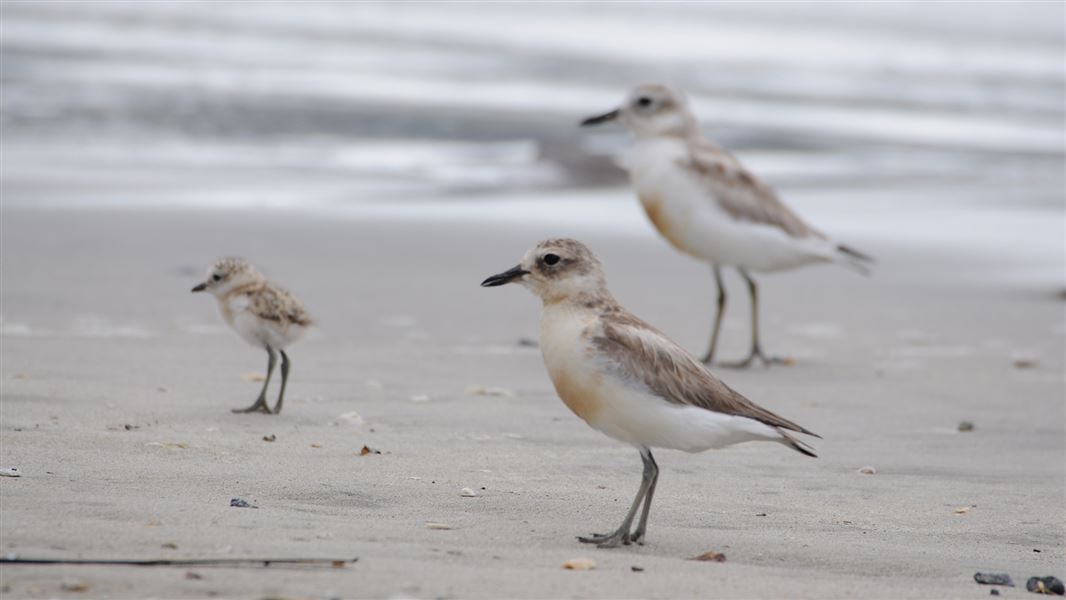New Zealand status: Endemic
Conservation status: Recovering
Found in: Coastal areas around parts of the North Island
Threats: Predation, habitat loss, disturbance, tide and storm surges
Sound recordings:
New Zealand dotterel/tūturiwhatu song (MP3, 3,371K)
03:35 – New Zealand dotterel song.
Our bird songs can be reused, even commercially, according to our copyright terms.
Species information: New Zealand dotterel on NZ Birds Online.
Brochures:
Image gallery
There is estimated to be more than 2,500 Northern New Zealand dotterels/tūturiwhatu. The population is recovering.
However, the birds are still at risk from the impacts of coastal development on habitat, introduced predators and disturbance during breeding seasons.
Other names: Northern red-breasted plover, tūturiwhatu-pukunui, rako
Distribution
The Northern New Zealand dotterel/tūturiwhatu is found in suitable habitat from Taranaki northwards on the west coast, and from North Cape southwards along the east coast of Northland, Auckland, the Coromandel Peninsula and Bay of Plenty, and as far south as Mahia Peninsula.
Within the Auckland and Northland regions, they nest on beaches including:
- Mangawhai
- Waipu
- Te Arai Stream
- Poutawa Stream
- Pakari River mouth
- Omaha Spit
- Tawharanui
- Papakanui Spit
- Beehive Island
- Waiwera
- Gulf Harbour
- Wade River mouth
- Tapora
- Beaches south of Auckland City
- Waiheke and Great Barrier Islands.
On the Coromandel peninsula, their major breeding sites are Opoutere Beach, Matarangi and Pauanui. They also nest on the waste rock embankment at Newmont Waihi Gold’s Martha Mine in Waihi and the Lakes Resort Golf Course near Pauanui.
They can also be found at Onemana, Whangamata, Whiritoa, as well as rocky beaches on the Thames Coast.
Post-breeding flocks
In late summer, the birds leave their breeding sites and congregate in post-breeding flocks at favoured estuaries. These flocks are socially important; birds which have lost partners during the breeding season can find new ones, and young birds pair for the first time.
Some areas where these flocks occur are Mangawhai (150 birds), Waipu (30-40 birds), Omaha (70-80 birds), Tapora (40-45 birds), Wade River (20-25 birds), and Whangapoua Estuary on Great Barrier Island/Aotea (40-50 birds).
Did you know?
New Zealand dotterel will fake an injury to draw intruders away from their nest.
Threats
Habitat loss and disturbance
The Northern New Zealand dotterel/tūturiwhatu nests in open sites, typically low-lying sand, gravel banks or sandbars close to beaches and lagoons. Nests just above high tide mark are easily lost to strong storms and very high spring tides.
The birds often nest close to residential or developed areas. Their breeding habitats are at risk from development and subsequent erosion.
On the beach, nests are easily destroyed by careless feet, dogs and off-road vehicles. When adults are disturbed while incubating and leave the nest, the eggs are at risk of overheating. When young chicks are disturbed, they can die from exhaustion as they cannot eat in time, or get to their feeding grounds at the water’s edge.
Uncontrolled dogs running through nesting areas can crush eggs, disturb nesting adults and kill chicks. Many beaches have dog restrictions and owners should be aware of these – respect and obey them.
Predators
Hedgehogs, stoats, cats and rats are the most common predators of eggs and chicks.
Hedgehogs are a major predator as they can move up to 2 kilometres in one night, eating eggs from nests along the way. Hedgehogs and stoats are controlled by trapping.
Cats and stoats also kill some adult birds, especially during the breeding season. Unfledged chicks are easy prey for cats.
In some areas, other birds are threats. Black-backed gulls and harrier hawks are two common predators. An effective form of protection from birds of prey are logs, with open-ended palm fronds used to create an escape route for chicks.
Conservation
Wardens at key sites
At key sites DOC wardens inform the public of nesting areas. These are roped off and sign posted.
DOC staff and volunteers participate in predator control and regularly check traps during the nesting season.
Matakana Island dotterel project
Matakana Island has become the home of an excellent dotterel breeding programme due to its innovative community approach.
Matakana Island dotterel project
You can help
Get involved
Around Northland, survival of the Northern New Zealand dotterel is mainly thanks to individuals and community groups. Get involved by contacting the Bay of Islands office.
In the Auckland region you can support the Omaha Shorebird Protection Trust.
Around the Coromandel, you can become a dotterel minder, or find out more by emailing DOC’s Hauraki or Coromandel District offices at coromandeldistrict@doc.govt.nz or hauraki@doc.govt.nz.
For other areas, contact your local DOC office.
When visiting dotterel areas
- Stay out of roped-off areas and follow the signs.
- Keep dogs and vehicles off beaches and sandspits.
- If you see a NZ dotterel feigning injury (it may ‘drag’ a wing as if it is broken), it has a nest or chicks nearby. Move away slowly and carefully.
